Tired of viewers complaining about your stream’s audio? Studies show that crystal-clear audio is crucial for keeping your audience engaged. Has muffled or distorted sound ruined your stream? An audio interface can be the game-changer you need!
Getting the right audio interface unlocks the full potential of your XLR microphone, delivering studio-grade sound to your streaming setup. Keep these key factors when purchasing to make the right choice.
- Audio Quality: Check the interface’s audio resolution and sampling rate. Higher resolution and sample rates (e.g., 24-bit/192kHz) result in better sound quality and clarity.
- Compatibility: Ensure that the audio interface is compatible with your streaming setup. Check for compatibility with your operating system (e.g., Windows, macOS) and streaming software (e.g., OBS Studio, XSplit).
- Latency Performance: Low latency is crucial for real-time monitoring and live streaming. Look for interfaces with round-trip latency of 2ms or less.
- Build Quality: Choose an interface built with sturdy materials and reliable components to ensure durability and longevity.
Outline
ToggleBest Audio Interface for Streaming Table
| Best Audio Interface for Streaming | No.of Channels | Audio Resolution | Buy Now |
|---|---|---|---|
| MAONO Audio Interface for Streaming | 9 | 16-bit/48kHz | Check On Amazon |
| PreSonus Audio Interface for Streaming | 2 | 24-bit/96 kHz | Check On Amazon |
| IK Multimedia Audio Interface for Streaming | 4 | 24-bit/96 kHz | Check On Amazon |
| Wrugste Audio Interface for Streaming | 2 | 24-bit/96 kHz | Check On Amazon |
| Pyle Audio Interface for Streaming | 2 | - | Check On Amazon |
Best Audio Interface for Streaming Reviews
1. MAONO Audio Interface for Streaming
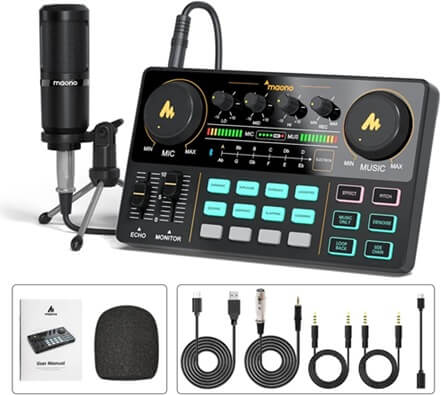
The device boasts a wide array of features, including eight pre-loaded sound effects, four customizable sound effects, and a pitch changer. Additionally, it supports multi-person and multi-device simultaneous live streaming, enabling seamless collaboration across various platforms. Its mixing, monitoring, and equalizer capabilities ensure your content sounds professional without requiring extensive post-production.
What sets this product apart is its focus on enabling content creators to concentrate on delivering valuable content and engaging with their audience, sparing them the complexities of intricate operations. Whether you’re a novice looking to kickstart your podcasting journey or a pro seeking a convenient, portable solution, the Maonocaster Lite is your ticket to hassle-free, high-quality content creation.
Best Features
- All-in-one design.
- Four channels of audio mixing.
- Easy connections to microphones, smartphones, and other sources.
- Comprehensive set of tools for controlling sound levels and adding live vocal and sound effects.
Pros
- Easy to use, even for beginners.
- Good sound quality.
Cons
- Some battery issues.
2 .PreSonus Audio Interface for Streaming
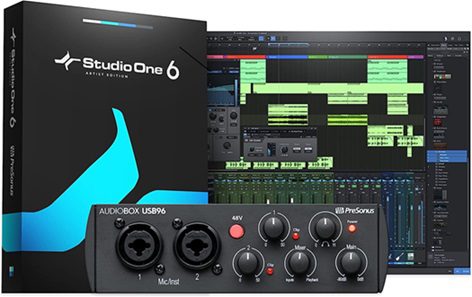
But that’s not all! When you buy it, you also get over $1000 worth of recording software for free. It’s like getting a bunch of cool tools to make your music even better. Plus, it’s super tough, so you can take it with you on the go.
Whether you’re a beginner or a pro, the PreSonus AudioBox USB 96 is perfect for making awesome music and podcasts without spending too much money. It’s like having your own recording studio in a small box. So, go ahead and start creating your masterpieces with this nifty little device.
Best Features
- High-quality 24-bit/96 kHz recording.
- Two Class-A mic preamps for clear sound.
- Versatile inputs, including MIDI support.
- Zero-latency monitoring and balanced outputs.
- Complete software package included.
- Durable, portable, and bus-powered.
Pros
- Powerful headphone output.
- Comprehensive software package.
Cons
- No customer support assistance.
3. IK Multimedia Audio Interface for Streaming
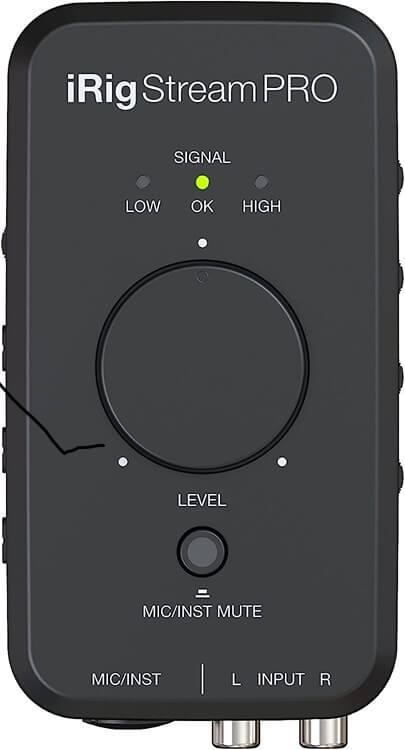
What sets the iRig Stream Pro apart is its commitment to delivering studio-quality sound, regardless of the device you’re using. Equipped with high-quality A/D and D/A converters, it ensures pristine audio with up to 96 kHz / 24-bit resolution, guaranteeing that your streams and recordings always sound their best.
User-friendly and compatible with a wide range of apps on iPhone, iPad, Android, Mac, and PC, it’s the go-to choice for musicians, podcasters, and live streamers seeking professional audio quality. Plus, features like Loopback+ and versatile power options make it a complete package for audio enthusiasts.
Best Features
- XLR / 1/4″ combo input with +48V phantom power for studio microphones.
- Stereo line input via RCA connectors for mixers, DJ decks, keyboards, and more.
- Headphone out with integrated mic input for listening and talking over the stereo input simultaneously.
- Device Loopback for mixing in audio or routing from app to app.
- Up to 96 kHz / 24-bit resolution for pro-level sound.
- Pre-mixes audio sources to stereo or 4 separate channels.
- Works with all your favorite apps.
Pros
- Compact and portable design.
- Versatile and can be used for a variety of applications.
Cons
- Low quality ports.
4. Wrugste Audio Interface for Streaming
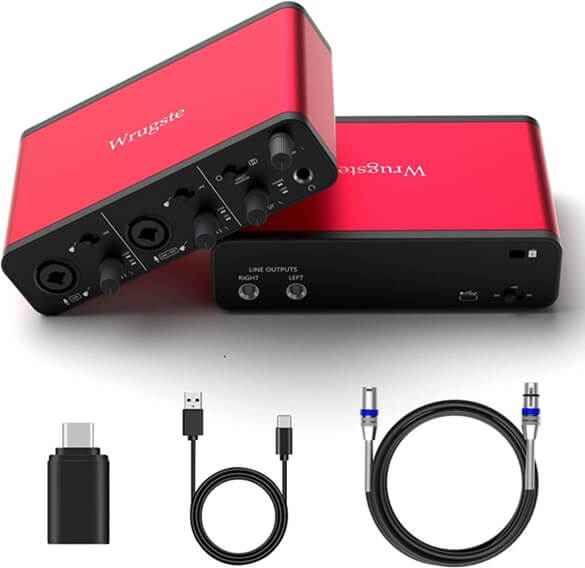
It works with popular recording software like Cubase and Ableton Live and is super easy to install on Windows 10, macOS, Android, and Linux. You can connect your microphone or instruments to it effortlessly. Plus, it has cool features like phantom power for microphones and direct monitoring for zero delay. When you get the package, it has everything you need to start, including cables and adapters.
And if you ever need help, the Wrugste team is there for you. With this audio interface, you can create incredible music and bring your sound to life, just like Wrugste promises – “Create Life with Sound.”
Best Features
- Versatile combo inputs for microphones, guitars, and instruments.
- High-quality 24-bit/192kHz audio recording.
- Real-time direct monitoring for accurate recording.
- +48V phantom power for studio condenser microphones.
- Rear panel line outputs for direct monitoring.
Pros
- Broad compatibility with software and OS.
- Manufacturer offers professional support.
Cons
- Not sufficient gain.
5. Pyle Audio Interface for Streaming
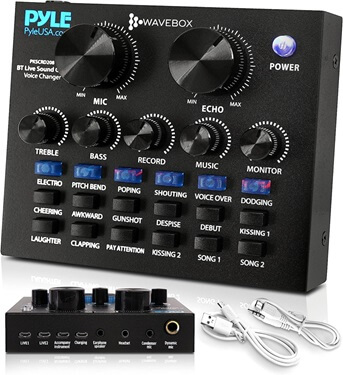
Equipped with a built-in DSP noise reduction chip, it ensures that your audio remains crystal clear by eliminating unwanted background noise. This mixer doesn’t stop at just enhancing audio quality; it also offers six sound modes and twelve sound effects, providing a playful and dynamic element to your streams and recordings.
With Bluetooth connectivity, you can effortlessly stream music wirelessly from your smartphone or tablet, eliminating cable clutter. Easy to use and compatible with major live broadcast software, ensuring that your content stands out with exceptional audio and creative sound effects.
Best Features
- DSP noise reduction for crystal-clear audio.
- 6 sound modes and 12 sound effects for fun and creativity.
- Bluetooth connectivity for wireless streaming.
- Easy to use and connect with USB plug-and-play.
- Compatible with major mainstream live broadcast software.
Pros
- High-quality audio.
- Wide range of features.
Cons
- Doesn’t have sufficient ports for mics.
Buying Guide for Best Audio Interface for Streaming
When selecting the best audio interface for streaming, it’s essential to dive into the specifics that contribute to superior sound quality and overall performance. This guide focuses on critical factors:
1. Number of Channels
Why it Matters: The number of channels on an audio interface determines how many audio sources you can simultaneously record or broadcast. For streamers, this could mean the ability to mix vocals, instruments, and other audio inputs in real-time, offering a richer and more dynamic audio experience to the audience.
What to Look For
- Solo Streamers: If you’re streaming alone, a 2-channel audio interface might suffice, allowing you to connect a microphone and an instrument or a second mic.
- Collaborative Streams: For those planning to include multiple participants or various audio sources, look for interfaces with 4 or more channels. This flexibility is crucial for managing complex audio setups without compromising quality.
2. Audio Resolution
Why it Matters: Audio resolution, measured in bits and sample rate, affects the clarity and depth of your sound. Higher resolution means the audio is captured and reproduced more accurately, which is essential for professional-sounding streams.
What to Look For
- Standard Quality: Look for a minimum of 24-bit depth and a 44.1kHz sample rate, the standard for CD-quality audio. This setup provides clear and detailed sound for most streaming needs.
- Professional Quality: For audiophiles or those requiring the highest audio fidelity, aim for interfaces supporting up to 192kHz sample rates. This range ensures superior sound detail, ideal for music production or high-definition streams.
3. Connectivity
Why it Matters: The connectivity options of an audio interface determine how it interfaces with your computer and other devices. It affects not only the quality of the audio signal but also the compatibility with your existing setup and the ease of use.
What to Look For
- USB: Most common and compatible with both Windows and Mac, USB interfaces are user-friendly and sufficient for basic setups.
- Thunderbolt: Offers faster data transfer rates, which is beneficial for handling multiple channels of high-resolution audio with minimal latency. Ideal for professional setups and newer Mac models.
- Additional Ports: Consider interfaces with MIDI, line inputs, and outputs for connecting synthesizers, drum machines, or external processors. This expands your setup’s versatility for different streaming scenarios.
4. Bit Depth
Why it matters: Bit depth impacts the audio interface’s ability to accurately capture the nuances and details in sound. A higher bit depth allows for a wider dynamic range, meaning the quietest and loudest parts of your audio can be more precisely recorded and reproduced without noise or distortion.
What to Look For
- Standard: 24-bit depth is widely considered a professional standard for streaming, offering a good balance between file size and audio quality.
- High-End Requirements: While 16-bit might suffice for basic streaming, aiming for 24-bit provides a noticeable improvement in sound quality, particularly for dynamic performances or high-quality music streams.
5. Sample Rate
Why it Matters: The sample rate defines how often the audio signal is sampled per second, affecting the fidelity and smoothness of the sound. Higher sample rates can reproduce higher frequencies and contribute to a more accurate and detailed sound reproduction.
What to Look For
- CD Quality: 44.1kHz is the sample rate used for CDs and is adequate for most streaming needs.
- Professional Quality: For audiophiles or professional music streams, consider interfaces that offer sample rates of 96kHz or even 192kHz to ensure the highest audio fidelity.
6. Gain Range
Why it Matters: The gain range of an audio interface indicates how much you can amplify your microphone or instrument signal without introducing noise. A wide gain range is crucial for accommodating different types of microphones and sources, ensuring your audio is clear and free from unwanted distortion or hiss.
What to Look For
- Versatility: Look for an audio interface with a wide gain range, typically from as low as 0 dB for line-level sources up to 60 dB or more for dynamic microphones.
- Low Noise: Ensure the preamps are of high quality, offering clean gain without noise at higher levels, which is particularly important for dynamic mics or when capturing quiet sources.
7. Sound Effects
Why it Matters: Built-in sound effects, like reverb, compression, and EQ, can enhance your audio quality directly from the interface, providing a polished and professional sound. These effects can help manage levels, improve clarity, and add depth to your stream without needing post-production.
What to Look For
- Quality Over Quantity: Focus on interfaces that offer high-quality, usable effects rather than a large number of gimmicky ones. Reverb and compression are particularly useful for live vocals or instruments.
- Software Integration: Some interfaces come with software that allows for more detailed manipulation of these effects in real-time, offering greater control over your sound during live streams.
Audio Interface for Streaming – FAQs
Ans: Yes, an audio interface significantly improves the audio quality of your streams.
Ans: Yes, there are wireless options available, but they might have limitations compared to wired interfaces.
Ans: An audio interface enhances your streaming experience by providing superior sound quality, reducing latency, and offering greater control over your audio settings.
Ans: Not necessarily. There are budget-friendly options that offer excellent sound quality. Your choice should align with your specific needs and long-term goals.
Conclusion
The best audio interface for streaming depends on your specific needs and budget. When choosing an audio interface for streaming, it’s important to consider your specific needs. Think about the number of channels you need, the audio resolution you want, and the type of connectivity you need. It’s also important to make sure that the audio interface you choose is compatible with your computer.
- If you’re looking for a more professional audio interface, the PreSonus Audio Interface for Streaming is a good choice. It offers high-quality sound and a variety of features, including two XLR inputs, two TRS outputs, and MIDI I/O.
- If you’re looking for a budget-friendly audio interface, the Wrugste Audio Interface for Streaming is a good option. It’s not as feature-rich as some of the other options on this list, but it still offers decent sound quality and is easy to use.
- If you’re looking for a versatile audio interface that can be used for both streaming and podcasting, the Pyle Audio Interface for Streaming is a good option. It has a variety of inputs and outputs, as well as a built-in sound modes and sound effects.
No matter what your budget or needs are, there is an audio interface out there that is perfect for you. Do some research and compare different models to find the best one for you.

